



Shelley History - The People
Eric Walter Slater (1902-1984)
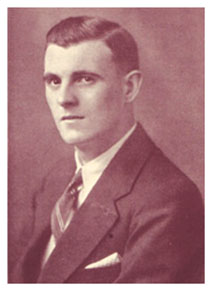
Eric was born in Longton in 1902 and attended the local school. After leaving school at the age of fifteen, he joined the North Staffordshire Railway Company where he was hoping to become an engineer. He spent nine months working on the shop floor before moving to the drawing office, where he worked for twelve months before deciding it was not what he wanted to do.
In 1919, at the age of seventeen, he joined Shelley Pottery to work alongside his father, Walter, who was the Art Director. On joining the company, he started his training at the local art schools; Stoke for modelling and design, Burslem for design and Hanley for life classes and design. The training lasted for seven years and he attended the schools for two afternoons and five nights a week. In 1923 he won the award for 'Best Student of the Year'.
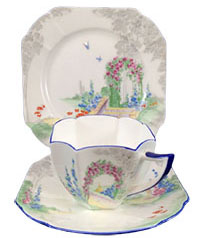
During the mid-1920s Eric continued to work alongside his father and for a few years, his younger brother Kenneth and Kenneth’s new wife, Clara Knight, who was also a designer and decorator, before they both emigrated to Canada. With the launch of the octagonal Queen Anne shape in 1926, a new era of design was being introduced at the factory. Once the shape was established, the wide range of patterns was thought to have been a collaboration between the three family members. With the growing success of the Queen Anne shape and some of the designs, especially those which became known as ‘The Archway of Roses’ number 11606 and ‘Sunset and Tall Trees’ number 11678, Eric was reaching his full confidence as a designer and he was starting to be widely recognised for his designs.
In 1930 he introduced two shapes which were ultra-modern in design and were totally different from anything that the firm had previously produced. The conical form and triangular solid handles had not been seen in the industry before and soon competitors including Paragon, Wedgwood and E.C. Brain created similar shapes in china, and Clarice Cliff the conical shape in earthenware. None of them were able to produce the high-quality bone china that Shelley was renowned for. The shapes were named Vogue and Mode.
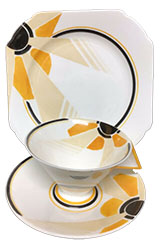 Vogue was the wider of the two shapes, whilst the Mode was narrower and slightly taller. They were produced in tea and coffee sizes. Designs that were produced for the shapes were geometric and floral motif styles. One of the designs that was very successful was the Sunray pattern number 11742 in the black and orange colourway and became a characteristic of the 1930s. Dinnerware was also produced in the Vogue shape. The designs and patterns were met with a guarded reception when first introduced, The Pottery Gazette wrote: ‘They may or may not carry the public by storm, but one thing they certainly will do, they will cause people to stop and think… There are those who for a long time past have been agitating for a more adventurous spirit in the manufacturing circles of the pottery trade. Well, here it is!’
Vogue was the wider of the two shapes, whilst the Mode was narrower and slightly taller. They were produced in tea and coffee sizes. Designs that were produced for the shapes were geometric and floral motif styles. One of the designs that was very successful was the Sunray pattern number 11742 in the black and orange colourway and became a characteristic of the 1930s. Dinnerware was also produced in the Vogue shape. The designs and patterns were met with a guarded reception when first introduced, The Pottery Gazette wrote: ‘They may or may not carry the public by storm, but one thing they certainly will do, they will cause people to stop and think… There are those who for a long time past have been agitating for a more adventurous spirit in the manufacturing circles of the pottery trade. Well, here it is!’ The Vogue and Mode shapes were only in production for two years. The wide shape of the Vogue allowed the hot drink to cool quickly and the solid handle was difficult to hold. Shelley’s received complaints that the cups could not be hung up, due to the solid handle.
To solve those problems in March 1932, Eric introduced another new cup shape. This was named Eve in the same style as the Mode shape, but the handle had been modified to an open triangle. The designs on the Eve shape were similar to those that were produced on the Mode shape and these continued until the late thirties.
Whilst the Vogue and Mode shapes did not last more than a couple of years, the next shape that Eric introduced after Eve, was still in production in the 1960s. This was the Regent shape, the straight lines of Vogue, Mode and Eve had given way to curves and the body of the cup was a flared trumpet shape with a full round handle. This was a practical design, comfortable to hold, well balanced and easy to drink from.
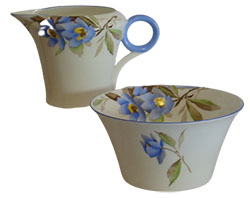 The respected Gordon Forsyth selected the Regent shape to illustrate good design in his book ‘20th Century Ceramics’; an international survey of the best work. The patterns that were first applied to Regent were a complete change from those that had been used on the Vogue and Mode shape, they were mainly of floral subjects. The first design was a blue flower called Syringa, another popular design was the Anemone Bunch.
The respected Gordon Forsyth selected the Regent shape to illustrate good design in his book ‘20th Century Ceramics’; an international survey of the best work. The patterns that were first applied to Regent were a complete change from those that had been used on the Vogue and Mode shape, they were mainly of floral subjects. The first design was a blue flower called Syringa, another popular design was the Anemone Bunch.
The Society of Industrial Artists, founded in 1930, set up a North Staffordshire branch in 1932. Two people who were well known in art and design were Susie Cooper and Reginald Haggar, both founder members. Lively debates were organised on the issue of modern art in pottery design. In 1933 Eric was elected onto the committee alongside Gordon Forsyth, Susie Cooper, Colley Shorter (Clarice Cliff’s husband) amongst others. In 1935 the Society of Industrial Artists branch held a competition amongst its members for original designs. Eric won first prize for a modern styling of dinner-ware. The design was a simple motif at the centre and delicate shading to the rim. Eric’s Eve and Regent shapes were selected that year for inclusion in the important ‘Survey of British Industrial Arts’ by Henry Dowling. So, the 1930s marked the blossoming of his career and his establishment as a distinctive stylist, something that he maintained throughout his working career at Shelley’s
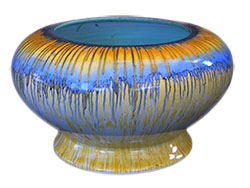
In 1932, a large range of hand decorated earthenware pieces was introduced and given the name Harmony Artware. The range started off as simple banded ware, either with graduating shades of one colour or a variety of colours and shades which complemented each other. One day Eric was experimenting with different colourways for the banded ware range and whilst turning the piece on a wheel, he stopped the wheel before the colour could hold its position and it ran, mingling with the other colours. Eric liked the effect that the runs of paint had produced, so he decided to generate some more and have them fired to see what the final appearance was like. The effect when fired was quite remarkable and when Eric showed it to Percy Shelley he agreed it would be well worth marketing. In 1933 the range was exhibited at the British Industries Fair and within a short period of time the Harmony Dripware proved so popular that twenty-five paintresses were needed to decorate the ware to fulfil the orders. Although the Harmony Dripware was initially produced on earthenware it was also applied to china ware included Vogue, Eve, Regent and Chester. In 1937 Eric’s father, Walter, retired and Eric succeeded him as Arts Director. When the Second World War started in 1939, the company continued to produce decorated ware for the overseas market and white ware for the home market.
After WW2, the Council of Industrial Design decided to hold an exhibition in 1946, to promote the products of British Industry. It was named ‘Britain Can Make It Exhibition’. In the pottery section, seven of the designs submitted by Shelley’s were selected. Of the seven designs, six were by Eric and one by an apprentice designer, Veronica Ball, who was a prodigy of Eric’s. In December 1945 Vincent Bob Shelley died. His brother Kenneth Jack had died in 1933; this left Percy Norman Shelley as the only board member. In 1946 Eric Slater and Ralph Tatton were elected onto the Board as Directors with Percy Shelley remaining as Managing Director. After the success of the ‘Britain Can Make It Exhibition’ the ‘Festival of Britain’ that had first been discussed in the later years of WW2 was held in 1951 to mark the centenary of the Great Exhibition of 1851.In the exhibition in London, Shelley china was shown in four pavilions. All the designs would have received much input from Eric. A travelling exhibition was also mounted and staged in several cities around the U.K. In the ‘Best Room’ of the People at Home section a lustre bowl and a series of jars were exhibited, the lustre bowl was hand painted by Eric.
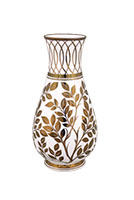 In 1952, Shelley’s revived the sgraffito and groundlaying decoration methods both designs being produced by hand decoration. Eric oversaw the small team of painters and paintresses which was led by James Hackett a young artist and designer. 1953 saw the centenary of the Burslem School of Art being celebrated by an exhibition of pottery by former students and teachers, past and present. Amongst the 184 pieces of pottery exhibited, ten were designed by Eric, demonstrating how highly regarded he had become within the industry.
After WW2, changes were taking place in the pottery industry and the company had to adjust to the new demands. Gone were the shapes of the 1930s and more traditional shapes and designs were reconsidered. With these changes Eric looked to introduce new cup shapes but based on earlier designs. Between 1950 and 1964, thirteen new cup shapes were introduced including two miniatures, offered with a variety of decorations in the gift ware range.
In 1952, Shelley’s revived the sgraffito and groundlaying decoration methods both designs being produced by hand decoration. Eric oversaw the small team of painters and paintresses which was led by James Hackett a young artist and designer. 1953 saw the centenary of the Burslem School of Art being celebrated by an exhibition of pottery by former students and teachers, past and present. Amongst the 184 pieces of pottery exhibited, ten were designed by Eric, demonstrating how highly regarded he had become within the industry.
After WW2, changes were taking place in the pottery industry and the company had to adjust to the new demands. Gone were the shapes of the 1930s and more traditional shapes and designs were reconsidered. With these changes Eric looked to introduce new cup shapes but based on earlier designs. Between 1950 and 1964, thirteen new cup shapes were introduced including two miniatures, offered with a variety of decorations in the gift ware range.In 1956 Eric introduced the Stirling cup shape which was in production for four years and proved popular during those years. The last shape to be introduced was Avon in 1964. Shelleys were taken over by Allied English Potteries in May 1966 and production was changed to Royal Albert ware. Eric Slater was put in
charge of the factory now renamed 'Montrose Works'. Eric retired in 1972 aged 70 years.